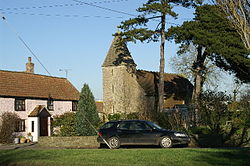Kenn, Somerset
| Kenn | |
| Somerset | |
|---|---|
 Church of St John The Evangelist, Kenn | |
| Location | |
| Grid reference: | ST415695 |
| Location: | 51°25’3"N, 2°50’25"W |
| Data | |
| Population: | 431 (2011[1]) |
| Post town: | Clevedon |
| Postcode: | BS21 |
| Dialling code: | 01275 |
| Local Government | |
| Council: | North Somerset |
| Parliamentary constituency: |
North Somerset |
Kenn is a small village and parish in the Winterstoke hundred of Somerset. It lies on the B3133 road near Clevedon in the North Somerset Levels. The civil parish has a population of 431.[1]
History
In the 19th century, Kenn was described as follows: "The village is small and situated in marshy ground. It formerly belonged to the Kenns, one of whom was the nonjuring bishop, composer of the 'Morning Hymn'; he was one of the seven prelates sent to the Tower by James II. The soil is loamy with subsoil clay. The vicarial tithes have been commuted for a rent-charge of £90. The living is a perpetual curacy in the diocese of Bath and Wells, in the patronage of the Vicar of Yatton. The church is a stone structure partially rebuilt in 1861. In the interior are several ancient monuments, among which is that of Christopher Kenn. The register dates from 1543."[2]
Kenn is notable as the site in 1830 of the last public hangings in the UK to be carried out at the scene of the crime. Three arsonists (William Wall, John Rowley and Richard Clarke) who had set fire to a local farmer's hay were hanged, another three being transported to Tasmania.[3]
Geography
Nearby is the Kenn Church, Kenn Pier & Yew Tree Farm SSSI, a geological Site of Special Scientific Interest which is listed in the Geological Conservation Review because it consists of a complex sequence of Pleistocene sediments, including coarse glacial outwash gravels at the base overlain by a complex sequence of interglacial freshwater, estuarine and marine sands. The sequence is then capped by aeolian (windblown) coversands and Holocene silts.[4]
Religious sites
The Church of St John The Evangelist has a Norman tower, with much of the rest of the church dating from around 1300. It has been designated as a Grade-II* listed building.[5]
References
- ↑ 1.0 1.1 "2011 Census Profile" (Excel). North Somerset Council. Archived from the original on 4 January 2014. https://web.archive.org/web/20140104204530/http://www.n-somerset.gov.uk/Environment/Planning_policy_and-research/researchandmonitoring/Documents/North%20Somerset%20Small%20area%20geography%20profiles%20tool.xls. Retrieved 4 January 2014.
- ↑ National Gazetteer of Great Britain and Ireland (1868) Transcribed by Colin Hinson, 2003
- ↑ Lilly, Derek B. & Lilly, Jane S. (1994). The Kenn Hangings of 1830: The Full Story. Weston-super-Mare: H. Galloway. ISBN 1-873931-23-9
- ↑ English Nature citation sheet for the site (accessed 13 July 2006)
- ↑ "Church of St. John The Evangelist". Images of England. English Heritage. http://www.imagesofengland.org.uk/Details/Default.aspx?id=33705. Retrieved 14 January 2009.
Outside links
| ("Wikimedia Commons" has material about Kenn, Somerset) |
